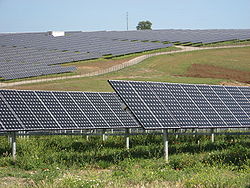
Serpa solar power plant
Encyclopedia

Serpa
Serpa is a municipality in Portugal, in Alentejo Region, with a total area of 1104.0 km² and a total population of 16,178 inhabitants. The Guadiana River flows close to the town of Serpa....
, in Portugal's Alentejo agricultural region, 200 kilometres (124.3 mi) southeast of Lisbon. The plant uses SunPower
SunPower
SunPower Corporation designs and manufactures high-efficiency crystalline silicon photovoltaic cells, roof tiles and solar panels based on a silicon all-back-contact solar cell invented at Stanford University. SunPower Corporation is publicly traded on the NASDAQ as SPWRA and SPWRB...
subsidiary PowerLight's PowerTracker system to follow the sun's daily path across the sky and generate more electricity than conventional fixed-mounted systems. The plant provides enough electricity to supply approximately 8,000 homes.
The Serpa solar power plant was developed by the Portuguese company Catavento and it incorporates photovoltaic modules from SunPower, Sanyo
Sanyo
is a major electronics company and member of the Fortune 500 whose headquarters is located in Moriguchi, Osaka prefecture, Japan. Sanyo targets the middle of the market and has over 230 Subsidiaries and Affiliates....
, Sharp
Sharp Corporation
is a Japanese multinational corporation that designs and manufactures electronic products. Headquartered in Abeno-ku, Osaka, Japan, Sharp employs more than 55,580 people worldwide as of June 2011. The company was founded in September 1912 and takes its name from one of its founder's first...
and Suntech. General Electric
General Electric
General Electric Company , or GE, is an American multinational conglomerate corporation incorporated in Schenectady, New York and headquartered in Fairfield, Connecticut, United States...
Financial Services provided the financing for the project as part of its Ecomagination program.
Generating electricity from the sun with no fuel costs or emissions, the Serpa plant is on a 60-hectare (150-acre) hillside and is a model of clean power generation integrated with agriculture. The project supports a European Union
European Union
The European Union is an economic and political union of 27 independent member states which are located primarily in Europe. The EU traces its origins from the European Coal and Steel Community and the European Economic Community , formed by six countries in 1958...
initiative by saving more than 30,000 tons a year in greenhouse gas emissions compared to equivalent fossil fuel
Fossil fuel
Fossil fuels are fuels formed by natural processes such as anaerobic decomposition of buried dead organisms. The age of the organisms and their resulting fossil fuels is typically millions of years, and sometimes exceeds 650 million years...
generation. The EU agreed to cut greenhouse gas emissions by at least 20 percent by 2020, from 1990 levels.
Portugal relies heavily on imported fossil fuels, and its carbon dioxide emissions have increased 34 percent since 1990, which is among the fastest rates in the world. To address this, the country is implementing some of the world's most advanced incentives for installing renewable energy
Renewable energy
Renewable energy is energy which comes from natural resources such as sunlight, wind, rain, tides, and geothermal heat, which are renewable . About 16% of global final energy consumption comes from renewables, with 10% coming from traditional biomass, which is mainly used for heating, and 3.4% from...
. The Serpa project relies on a preferential tariff mandated by the Portuguese government.
Solar power
Solar power
Solar energy, radiant light and heat from the sun, has been harnessed by humans since ancient times using a range of ever-evolving technologies. Solar radiation, along with secondary solar-powered resources such as wind and wave power, hydroelectricity and biomass, account for most of the available...
enjoys widespread support in Portugal, with the backing of 77 percent of the population, according to a European Commission study published in January 2007.
See also
- Renewable energy in PortugalRenewable energy in PortugalRenewable energy in Portugal was the source for 52% of the country's electricity generation in 2010 - an increase of 28% in 5 years.In 2001, the Portuguese government launched a new energy policy instrument – the E4 Programme , consisting of a set of multiple, diversified measures aimed at...
- Renewable energy in the European UnionRenewable energy in the European UnionThe countries of the European Union are currently the number two global leaders in the development and application of renewable energy. Promoting the use of renewable energy sources is important both to the reduction of the EU's dependence on foreign energy imports, and in meeting targets to combat...
- Energy policy of the European UnionEnergy policy of the European UnionAlthough the European Union has legislated in the area of energy policy for many years, and evolved out of the European Coal and Steel Community, the concept of introducing a mandatory and comprehensive European energy policy was only approved at the meeting of the European Council on 27 October...
- Renewable energy commercializationRenewable energy commercializationRenewable energy commercialization involves the deployment of three generations of renewable energy technologies dating back more than 100 years. First-generation technologies, which are already mature and economically competitive, include biomass, hydroelectricity, geothermal power and heat...

